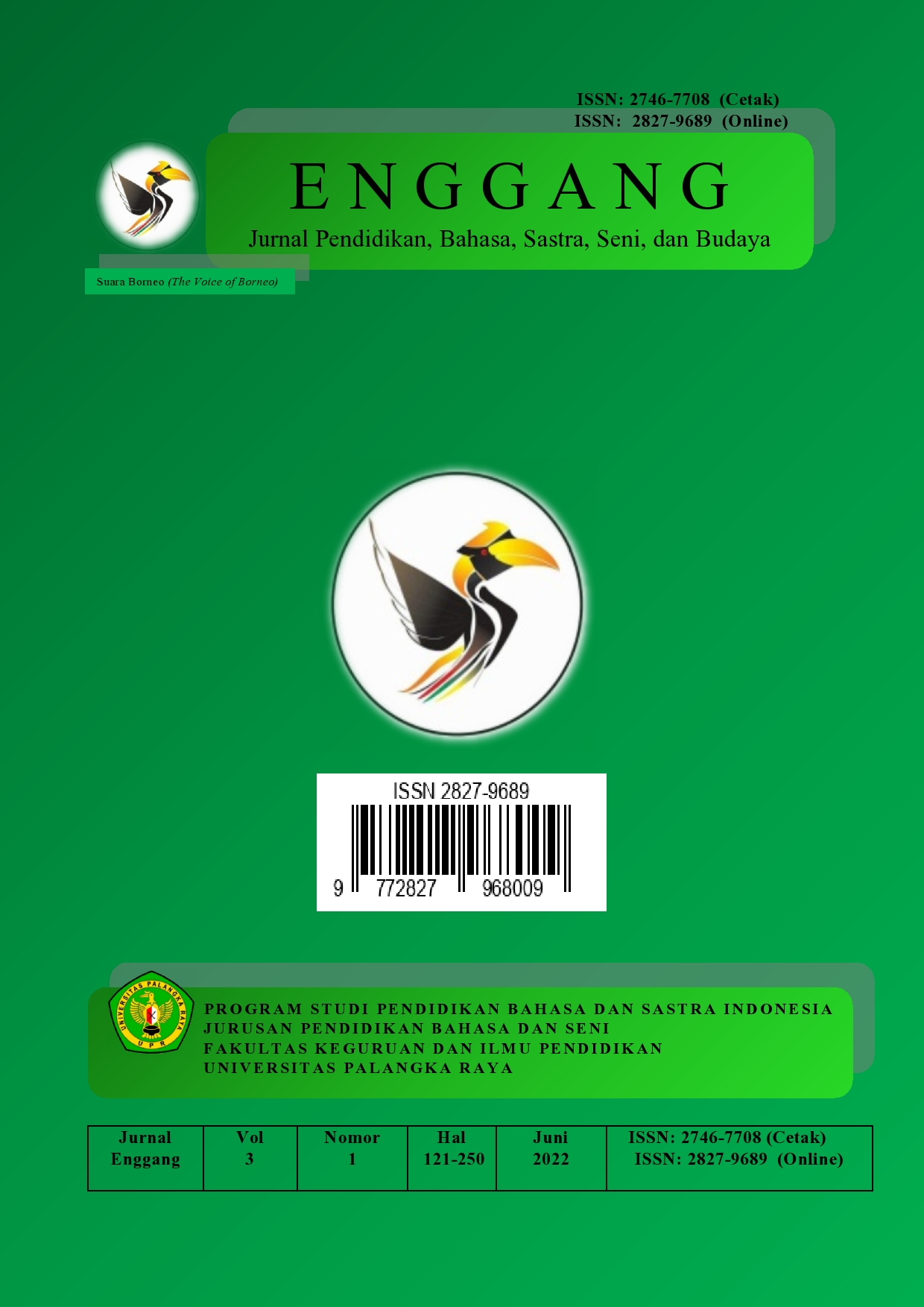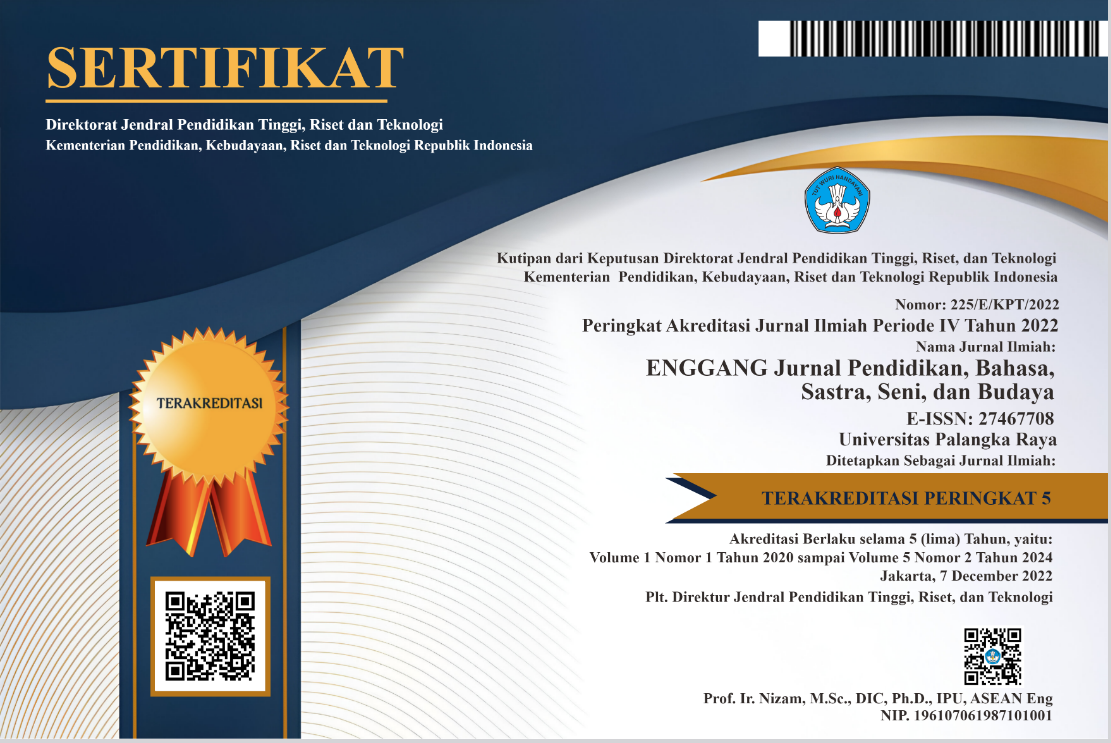Hirarki Kebutuhan Tokoh dalam Novel Malik & Elsa Karya Boy Candra
DOI:
https://doi.org/10.37304/enggang.v5i1.10399Keywords:
Hierarchy of Character Needs, Literary Psychology, NovelAbstract
Literary work is the only work of art that can represent the life of the writer and someone else in various forms so that it is related to h Likewise, novels are able to describe the broad and complex reality of human life to offer valuable lessons or morals for their readers. This study aims to describe aspects of the character hierarchy and offer an interpretation of the basic needs for survival of the characters through a literary psychology approach which can be used as an alternative to literary studies. The data source is the Malik & Elsa novel published by PT Transmedia Distributor. The focus of his research is the hierarchy of needs of figures with the theory launched by Maslow, the theory is named Abraham Maslow's hierarchy of needs t The formulation of the problem discusses physiological needs, a sense of security, belonging and love, and self-esteem. The research method used is descriptive-qualitative. Data collection techniques are reading, analysis and corpus techniques. The results showed that (1) Malik's physiological needs were met when he won the guessing game with Elsa. (2) The safety needs needed by Malik, in financial form. The aspect of feeling secure is fulfilled by working as a porter in the market. (3) Malik needs a love connection, in the form of love and affection from the opposite sex, namely Elsa. The sense of love and belonging between the two characters is fulfilled. However, due to caste differences between the two, they could not unite. (4) The esteem needs of Malik's character continue his college education.
Downloads
References
Aminuddin. (2002). Pengantar apresiasi sastra. Bandung: Sinar Baru Agensindo.
Azizah, L. N. (2021). Teori kebutuhan Maslow: Pengertian, konsep & pembagiannya. Gramedia Blog, 1–19.
Damono, S. D. (2009). Sosiologi sastra: Sebuah pengantar ringkas. Jakarta: Pembinaan dan Pengembangan Bahasa.
Damono, S. D. (2022). Pedoman penelitian sosiologi sastra. Jakarta: Pusat Bahasa.
Endraswara, S. (2003). Metodologi penelitian sastra. Yogyakarta: Pustaka Widyatama.
Endraswara, S. (2008). Metode penelitian psikologi sastra: Teori, langkah, dan penerapannya (p. 266).
Endraswara, S. (2013). Metodologi penelitian sastra, epistemologi, model, teori, dan aplikasi. Yogyakarta: CAPS (Center For Academic Publishing Service).
Esten, M. (2009). Kesustraan: Pengantar teori dan sejarah. Bandung: Angkasa.
Hanum, Z. (2016). Kritik sastra: Sebuah penilaian terhadap karya sastra. Tangerang: Pustaka Mandiri.
Jabrohim. (2003). Metodologi penelitian sastra. Yogyakarta: Hanindita Graha Widya.
Jabrohim. (2015). Teori penelitian sastra. Yogyakarta: Pustaka Pelajar.
Minderop, A. (2010). Psikologi sastra: Karya sastra, metode, teori, dan contoh kasus. Jakarta: Yayasan Pustaka Obor Indonesia.
Misnawati, M. (2023). Melintasi batas-batas bahasa melalui diplomasi sastra dan budaya: Crossing language boundaries through literary and cultural diplomacy. Pedagogik: Jurnal Pendidikan, 18(2), 185-193.
Nurgiyantoro, B. (2013). Teori pengkajian fiksi. Yogyakarta: Gadjah Mada University Press.
Nurgiyantoro, B. (2015). Teori pengkajian fiksi (Cetakan 1X). Yogyakarta: Gadjah Mada University Press.
Nurhayati. (2012). Pengantar ringkas teori sastra. Surakarta: Media Perkasa.
Ratna, N. K. (2011). Teori, metode, dan teknik penelitian sastra. Yogyakarta: Pustaka Pelajar.
Sadikin, M. (2010). Kumpulan sastra Indonesia. Jakarta Timur: Gudang Ilmu.
Siswanto, W. (2008). Pengantar teori sastra. Jakarta: PT Gara Sindo.
Siswanto, W. (2013). Penerapan teori sastra. Yogyakarta: Aditya Media Publishing.
Siswantoro. (2010). Metode penelitian sastra. Yogyakarta: Pustaka Pelajar.
Stanton, R. (2007). Teori fiksi (Terjemahan Sugihastuti). Yogyakarta: Pustakan Pelajar.
Suaka, N. (2014). Analisis sastra: Teori dan aplikasi. Yogyakarta: Penerbit Ombak.
Suantoko. (2019). Kajian sosiologi sastra-objektif karya sastra sebagai dokumen sosial dalam trilogi cerpen penembak misterius. Jurnal Edukasi Khatulistiwa, 2(2), 13-26.
Tarigan, H. G. (2011). Prinsip-prinsip dasar sastra. Bandung: Angkasa.
Wellek, R., & Warren, A. (2014). Teori kesusastraan. Jakarta: Gramedia.
Wellek, R., & Warren, A. (2016). Teori kesusastraan. Jakarta: Gramedia.
Wiyatmi. (2009). Pengantar kajian sastra. Yogyakarta: Pustaka Book Publisher.
Wiyatmi. (2011). Psikologi sastra. Yogyakarta: Kanwa Publisher.
Yanuarsih, S., et al. (2022). Realitas sosial budaya masyarakat Jawa dalam novel Gadis Pantai karya Pramoedya Ananta Toer. Piktorial, 1(4), 35-44.












